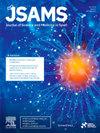重复研究:使用 Y 平衡测试调查最大无氧疲劳对动态姿势控制的影响
IF 3
2区 医学
Q1 SPORT SCIENCES
引用次数: 0
摘要
本研究的目的是复制约翰斯顿等人(2018 年)题为""的研究,作为大型复制项目的一部分。本研究旨在利用 Y 平衡测试确定最大无氧疲劳对动态姿势控制的影响,特别关注前伸距离。单节课干预。参加竞技体育运动的 40 名男女大学生(年龄:22 ± 3 岁,身高:171.88 ± 8.96 厘米,体重:76.20 ± 14.31 千克),在经过修改的 60 秒 Wingate 疲劳方案之前,分别在 20 分钟、10 分钟和 0 分钟完成了 Y 平衡测试方案。疲劳后评估在 Wingate 测试后 0、10 和 20 分钟完成。复制结果包括显著性、方向和使用 z 检验的效应大小比较。单向重复测量方差分析显示,最大无氧疲劳对归一化前伸方向有显著影响(F = 7.16, p = 0.002, η = 0.159; 95 % CI: 0.025, 0.320)。因此,我们在统计意义上复制了前伸距离的原始结果(F = 3.818,p = 0.025,η = 0.376;95 % CI:0.00,0.62)。使用 z 检验比较了前伸方向的复制和原始效应大小估计值,结果显示两者是一致的(z = 1.65,p = 0.05)。总体而言,我们在 Y 平衡测试中复制了最大无氧疲劳对前伸距离影响的原始研究结果。本文章由计算机程序翻译,如有差异,请以英文原文为准。
Replication study: Investigating the effects of maximal anaerobic fatigue on dynamic postural control using the Y-Balance Test
Objectives
The aim of this study was to replicate the study titled “Investigating the effects of maximal anaerobic fatigue on dynamic postural control using the Y-Balance Test” by Johnston et al. (2018) as part of a large replication project. This study aimed to determine the effects of maximal anaerobic fatigue on dynamic postural control using the Y-Balance Test, with a specific focus on anterior reach distance.
Design
A single session intervention.
Methods
Forty male and female university students (age: 22 ± 3 years, height: 171.88 ± 8.96 cm, mass: 76.20 ± 14.31 kg) partaking in competitive sport, completed a Y-Balance Test protocol at 20, 10, and 0 min before a modified 60 s Wingate fatiguing protocol. Post-fatigue assessments were completed at 0, 10, and 20 min after the Wingate test. Replication outcomes included significance, direction, and effect size comparison using a z-test.
Results
A one-way repeated measures ANOVA showed a significant effect for maximal anaerobic fatigue on normalised anterior reach direction (F1.82, 69.03 = 7.16, p = 0.002, ηp2 = 0.159; 95 % CI: 0.025, 0.320). Therefore, we replicated the original findings for anterior reach distance in terms of statistical significance (F = 3.818, p = 0.025, ηp2 = 0.376; 95 % CI: 0.00, 0.62). The replication and original effect size estimates for anterior reach direction were compared using a z-test and were deemed compatible (z = 1.65, p = 0.05).
Conclusions
Overall, we replicated the original study findings for the effect of maximal anaerobic fatigue on anterior reach distance in a Y-Balance Test.
求助全文
通过发布文献求助,成功后即可免费获取论文全文。
去求助
来源期刊
CiteScore
7.40
自引率
10.00%
发文量
198
审稿时长
48 days
期刊介绍:
The Journal of Science and Medicine in Sport is the official journal of Sports Medicine Australia (SMA) and is an an international refereed research publication covering all aspects of sport science and medicine.
The Journal considers for publication Original research and Review papers in the sub-disciplines relating generally to the broad sports medicine and sports science fields: sports medicine, sports injury (including injury epidemiology and injury prevention), physiotherapy, podiatry, physical activity and health, sports science, biomechanics, exercise physiology, motor control and learning, sport and exercise psychology, sports nutrition, public health (as relevant to sport and exercise), and rehabilitation and injury management. Manuscripts with an interdisciplinary perspective with specific applications to sport and exercise and its interaction with health will also be considered.

 求助内容:
求助内容: 应助结果提醒方式:
应助结果提醒方式:


